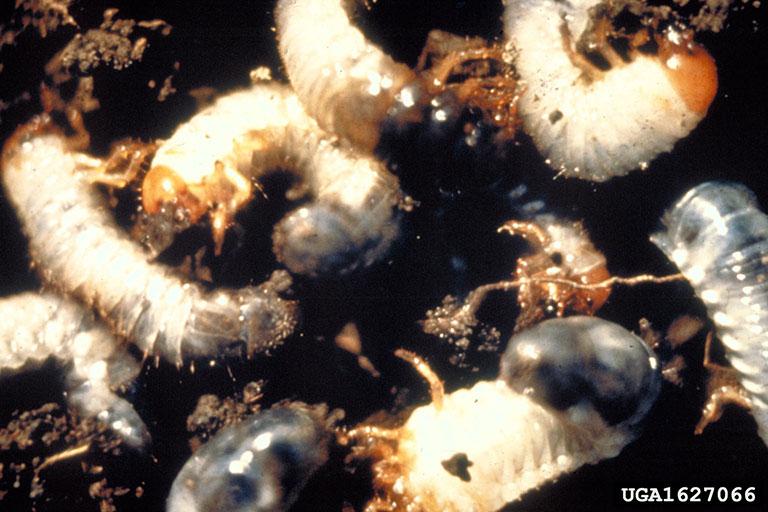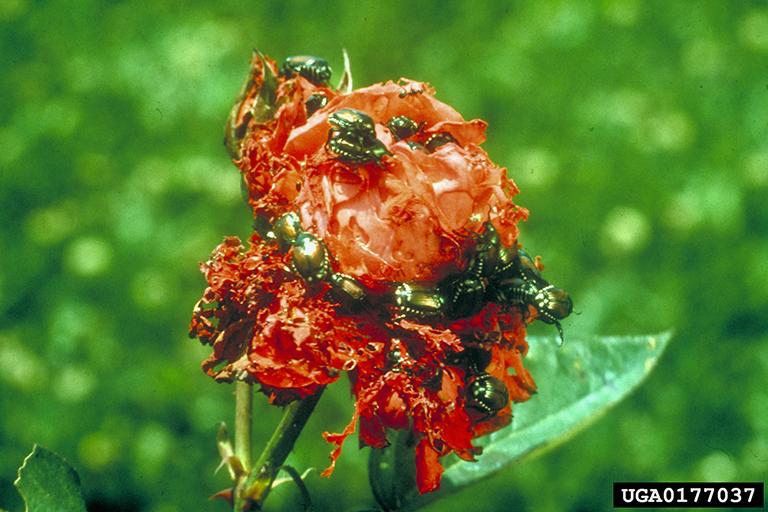Management Strategies for Nurseries, Garden Centers, Sod Farms and Landscape Contractors
The Colorado Nursery Act and the Japanese Beetle quarantine require that plants sold must meet apparent pest freedom criteria. Penalties for selling or moving infested plants could be as high as $1,000 per plant.
Nurseries with documented Japanese beetle presence that are not under a compliance agreement and following an active management program addressing critical control points and best management practices for the pest will not be allowed to sell nursery stock to clientele located outside the 11 county Front Range quarantine area.
There are several critical control points to target when managing Japanese beetle.
- Critical Control Points to Target
Critical Control Point Best Management Practice Buy in of infested stock either from out-of-state vendors or in-state-vendors in known JB infested areas of Colorado. 1. Abide by the Colorado Japanese Beetle Quarantine. All nursery stock purchased from States located east of Colorado including New Mexico must meet the restrictions of Colorado’s Quarantine. CDA inspectors check records of all imported stock for compliance.
2. Have knowledgeable staff watch trucks being unloaded, regardless of origin. Inspect and segregate plants into holding areas.
Adults fly in/move in from neighboring source 1. Monitor plants and look for JB adults and feeding damage-adults are active Mid-June through Mid-September.
2. Preventively treat (Appendix II) susceptible plants with insecticides. It is illegal to move Japanese beetles on plant material to areas of Colorado that do not have this pest.
3. Incorporate a granular insecticide in media.
Prevent egg laying 1. Female beetles will lay eggs in turf and other grasses. Eliminate or treat displays with permanent turf or grass plantings.
2. Cover bare soil with gravel, weed barrier or similar.
Know species susceptibility (preferred host list above) 1. Eliminate "pet" plants or susceptible hosts in the retail 'landscape'/permanent displays.
2. Resistant or non-host plants do not need to be protected.
3. Move smaller susceptible hosts into a screened or protected area, away from JB attack.
Educate clientele 1. Talk about resistant and non-host plants to clientele.
2. Explain how the nursery is managing this pest and by doing so your nursery is certified to be adequately mitigating the risk of Japanese beetle spread.
General Quarantine Compliance Restrictions and Approved Pesticides
Container Plants:
1. Potting media used must be soilless or sterile.
2. Containers must be clean.
3. Maintenance, unloading and loading crews will be trained to be observant for Japanese beetle and Japanese beetle damage.
4. All out of state sourced plant material entering meets current CO Japanese beetle quarantine restrictions.
5. Imported plant material and nursery stock with root balls larger than 32" and exposed to more than one Japanese beetle flight season (June-September) are not eligible for distribution outside the 11 county quarantine area.
6. Label or physically separate ineligible plant material indicating they are not to be sold to clientele outside the quarantine area.
Ornamental Grasses in containers smaller than 12" in diameter:
7. This is a prophylactic drench treatment protocol targeting eggs and early first instar larvae.
8. If the containers are exposed to a second flight season they must be retreated.
9. The prophylactic treatments must be the following:
a. Imidacloprid (Marathon 1% G-EPA Reg # 432-1329-59807 and 60wp-epa reg# 432-1361-59807, Imida E-Pro - EPA Reg # 81959-22, Quali-Pro Imidacloprid 2F - EPA Reg # 53883-232-73220 and AM Tide Imidacloprid 2F - EPA Reg # 83851-14.) Follow label directions.
b. Bifenthrin (Talstar Select insecticide, Onxypro insecticide). Apply as a drench, approximately four (4) fl. oz. of tank mix per six (6) inches or container diameter.
c. Thiamethoxam (Meridian 25 wg.). Apply as a partial drench (1/3 of full drench volume) at a rate of 1.95 oz. in 17 gal. water.
Container Certification: Containerized Nursery Stock Accreditation Program. Containerized nursery stock can be certified if grown under all of the following conditions. Ornamental grasses and sedges, which have been identified as preferred hosts of the Japanese beetle, will not be allowed certification under this program.
10. Only containers with a diameter of 16 inches or less and a volume less than 2646 cubic inches are allowed certification under the containerized Nursery Stock Accreditation program.
11. All containers shall be maintained apparently free of weeds.
12. All containers are maintained on top of gravel or landscape cloth kept free of weeds and soil.
Overwintered Product - Treatment of Rootballs/Containers between 12" and 32" diameter
13. All balled and burlapped, potted and containerized nursery stock with a rootball diameter of 32 inches or smaller are eligible for certification with this option. The potted or bailed and burlapped stock must be dipped, in on of the insecticides listed below, so as to submerge the entire root ball and all growing media of the container or the root retaining materials into the solution. The submersion time must be a minimum of two (2.0) minutes or until the complete saturation occurs, as indicated by the cessation of bubbling whichever time is longer. Upon removal from the solution, the plants must be drained in an approved manner.
14. Plants must not be shipped before they are well drained and can be easily handled. Media must be at least 50 degrees Fahrenheit at the time of treatment. The dip treatment targets Japanese beetle larval stages. Growing medium must be of moderate moisture content (not too wet or not too dry) so that pesticide will adequately penetrate the medium. Treatment must be applied between September 1 and April 15 in southern states and between September 1 and May 1 in the northern states as determined by the appropriate phytosanitary official in the exporting state. During the adult flight period, all treated plants must be protected from re-infestation.
a. Chlorpyrifos (4E formulations labeled for dipping, including Dursban 4E). Apply at a rate of one-quarter (0.25) pound active ingredient (8 ounces per 100 gallons of water).
b. Bifenthrin (OnyxPro Insecticide- EPA Registration # 279-4269). Apply at a rate of 14.4 fl. oz per 100 gallons of water or 1 lb/gal.
15. Balled & burlapped or field-potted plants, harvested from production fields, must be treated, with one of the insecticides listed in this section 5.00 (c b) (ii) below, before harvest using a band width six (6) inches wider than the actual root ball diameter to be dug. Do not allow the bands in adjacent rows to overlap. Apply May through July with a minimum of eighty-seven (87) gallons of water per acre.
a. Imidacloprid (Marathon 1% G – EPA Reg # 432-1329-59807 and 60WP- EPA reg # 432-1361-59807, Imida E-Pro – EPA Reg #81959-22, Quali-Pro Imidacloprid 2F – EPA Reg #53883-232-73220 and AM Tide Imidacloprid 2F – EPA Reg #83851-14). Follow label directions for Field and Forest Nursery applications. Review and adhere to Marathon label instructions regarding vegetation management and irrigation before and after application.
b. Imidacloprid + Cyfluthrin (Discus – EPA reg # 432-1392-59807). Use 17 fl. oz per 3,000 sq. ft. Thiamethoxam (Flagship 0.22G – EPA reg # 153719-23-4 and Flagship 25WG- EPA reg # 100-955). Use 120 lb per acre or 13.8 lb per 5,000 sq. ft. (Flagship 0.22G) or 8 oz per acre using a minimum of 1.5 gal. of water per 1,000 sq. ft (Flagship 25WG).
Mitigation of adult Japanese beetle
16. Attractive hosts that have been visually identified with feeding damage or adult beetle presence will be treated monthly with a labeled pesticide according to label directions beginning June and ending in September. Approved pesticides are listed in the U.S. Japanese Beetle Domestic Harmonization Plan, Appendix 11 (Category 2) revised June 20, 2016. (https://www.nationalplantboard.org/japanese-beetle-harmonization-plan.html)
Japanese beetle mitigation in sod
17. Sod may be approved for shipment to non-infested areas if the following management activities are performed.
- Maintenance of a Japanese beetle adulticide program on the sod farm periphery.
- Removal of Japanese beetle attractive hosts from the immediate growing area.
- Documentation of insecticide treatments between April 1 and July 31, targeting larvae.
- Labeled pesticides include:
- Labeled pesticides
Acelepryn® Insecticide Chlorantraniliprole Acelepryn® Granular Insecticide Chlorantraniliprole DupontTM AceleprynTM Insecticide 0.067% + Pro-
Mate® T&O FertilizerChlorantraniliprole Arena® 50WDG Insecticide Clothianidin Arena® 0.25G Insecticide Clothianidin AmTide Imidacloprid 2F T&O Imidacloprid BountyTM Turf & Ornamental Insecticide Imidacloprid CriterionTM 75WSP Insecticide Imidacloprid EnforceTM 75WSP Turf & Ornamental Insecticide Imidacloprid Lada® 2F Insecticide Imidacloprid Lesco® BanditTM 75WSP Insecticide Imidacloprid Malice® 75WSP Imidacloprid Merit® 75WP Insecticide Imidacloprid Merit® 75WSP Insecticide Imidacloprid Merit® 2F Insecticide Imidacloprid Quali-Pro® Imidacloprid 2F T&O Insecticide Imidacloprid Quali-Pro® Imidacloprid 75WSB Insecticide Imidacloprid Phoenix Hawk-I® 75WSP Imidacloprid Prokoz® Zenith® 2F Insecticide Imidacloprid Prokoz® Zenith® 75WSP Insecticide Imidacloprid Meridian® 0.33G Thiamethoxam Meridian® 25WG Thiamethoxam



